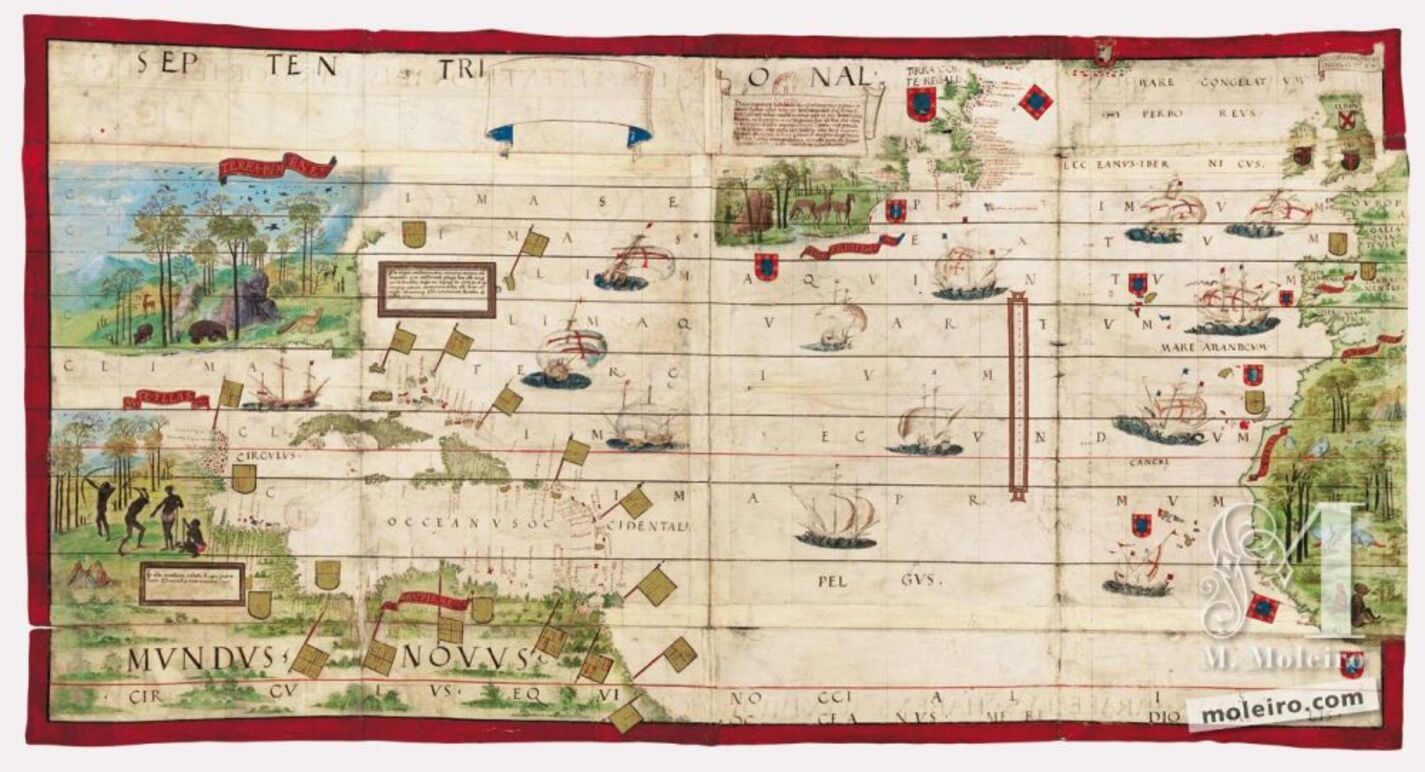Atlantic Ocean
The Atlas Miller only has one map showing the North Atlantic and the lands of the New World. However, it is a very interesting and large work that corresponds to what must have been one side of the enormous folding map in the bound atlas. The geographic scope ranges from Newfoundland to Guinea and from the Gulf of Mexico to the British Isles. Yet it cannot be classified as a hydrographic chart. Unlike all the other regional charts in the Atlas Miller, this one has no system of rhumb lines or wind-roses, which makes it impractical for navigational use. Rather, it is a work of pure geographical or geopolitical illustration, which explains why it is so superbly decorated and painted. Not only does it include individual illuminations showing ships, flora and fauna, etc., but also authentic rural and forest landscapes where several images are combined in an attempt to show them as a single whole. The images also sometimes use the illusion of perspective opening up into the distance, so as to emphasise the sheer size of the new lands that Europeans were then discovering in Africa and the New World.
Even though it could not be used for sailing, the map does have a scale and a meridian with latitude graduation, both located in the middle of the Atlantic Ocean and west of the Azores. The equator and the Tropic of Cancer are also illustrated, as are other parallels showing the Ptolemaic seven circles of climates in the northern hemisphere.
The bulk of the place-names (all written in Portuguese) appear along the Newfoundland coastline that belonged to Portugal under the Treaty of Tordesillas, and on the coastlines of the mainland and islands that belonged to Castile, written in a mixture of Portuguese and Castilian. However, there is not a single place-name written on the African coast before the Gulf of Guinea, where the Portuguese had long had their most important bases, including the Mina castle. This can only be a deliberate omission that was designed to make it more difficult to discover the route.
The map includes three main Latin captions: one on Newfoundland; another off Florida and the Antilles; the last on the Castilians’ Tierra Firme. There should also be a fourth, even bigger caption, whose cartouche was drawn at the top of the map, but nothing was actually written there. The first caption refers to the initial Portuguese discovery of Terra Corte Regalis (Newfoundland, etc.) and mentions that these northern regions are inhabited by savages who, despite being the same colour as the Europeans, are said to live like the ancient satyrs and fauns. It also mentions that the land is rough and mountainous, has many bears and other wild beasts, large rivers and watercourses that would make it easier to enter the inland regions – clearly a reference to the Gulf of Saint Lawrence. The second caption, alongside a very crudely drawn image of the Florida peninsula, states that the land, which was evidently poorly known then, is situated in the west and is part of what cosmographers called the mundus novus. It adds that the land is rich in gold and other goods, and that its southern border is with Brazil and its northern border is with Newfoundland and Norway (meaning Greenland). The third caption, which is very small, perhaps interrupted and located on the Spanish Antilles, simply notes that gold was found in those specific areas of the Antilles, which belonged to the king of Castile.
Alfredo Pinheiro Marques
Centro do Estudos do Mar Luís de Albuquerque
(Fragment of the Atlas MIller commentary volume)
